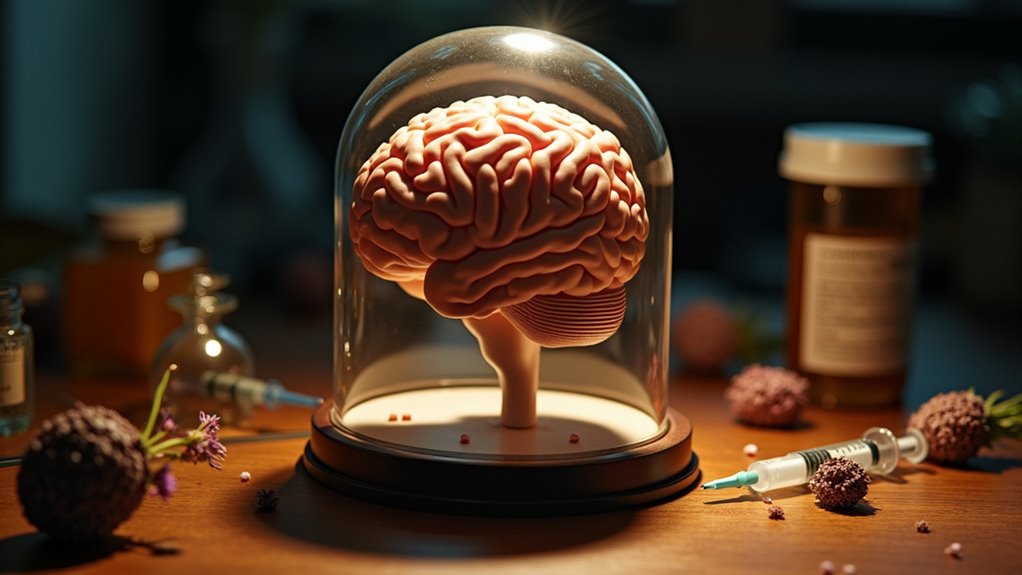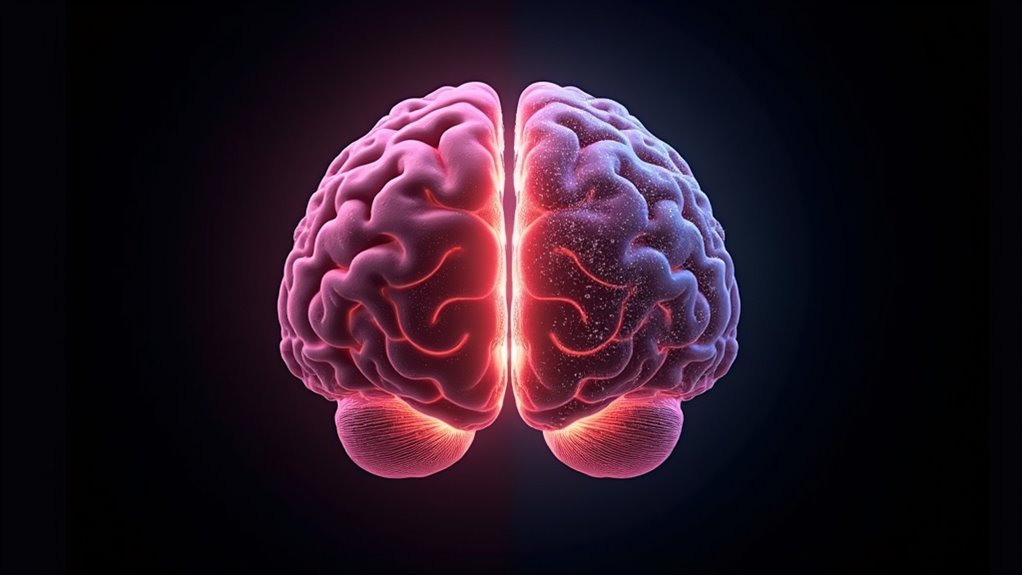Mental health and addiction are deeply interconnected, with over 42% of adults experiencing mental illness also using illicit substances. When you’re struggling with addiction, it creates measurable changes in your brain’s structure and chemistry, particularly affecting the prefrontal cortex and dopamine regulation. You’ll notice warning signs like mood swings, behavioral changes, and disrupted sleep patterns. Understanding these connections, along with proper support and treatment options, can vastly improve your chances of recovery and healing. The pathway to wellness begins with recognizing how your brain and mental health work together.
Understanding the Link Between Mental Health and Substance Use

The relationship between mental health and substance use disorders represents one of healthcare’s most complex and pressing challenges. When you’re dealing with mental illness, you’re extremely more likely to develop substance use issues – over 42% of adults with any mental illness use illicit drugs, compared to 21% without mental illness.
This interconnection creates a challenging cycle where each condition worsens the other. Recent data shows that 17.1 percent of Americans aged 12 or older currently meet the criteria for substance use disorder. Over 30 percent of adults reported symptoms of anxiety and/or depression in early 2023, highlighting the widespread nature of mental health challenges. Community outreach programs have become indispensable in addressing this dual crisis, especially as co-occurring serious mental illness and substance use cases increased by 40% between 2015-2019.
Family involvement dynamics play a fundamental role in recovery, as support systems help break the isolation that often accompanies these conditions. Understanding this link is essential because treating one condition while ignoring the other drastically reduces the chances of successful recovery.
The Science of Brain Changes in Addiction

While scientists once viewed addiction primarily as a failure of willpower, modern neuroscience reveals profound changes in brain structure and function that drive compulsive drug use. Addiction creates structural adaptations in key regions like the prefrontal cortex, where chronic substance use damages gray matter and impairs executive functions like decision-making and impulse control. These cognitive impairments are compounded by the fact that seeking becomes habitual rather than conscious. Brain imaging techniques like functional MRI scans reveal distinct physiological changes in addicted brains compared to healthy controls.
Your brain undergoes significant neurotransmitter imbalances, particularly in dopamine regulation. Drugs flood your system with 2-10 times more dopamine than natural rewards, leading to receptor downregulation and reduced sensitivity. Over time, you’ll experience changes in memory and learning pathways, where drug-related cues become powerfully encoded while your ability to form new, healthy memories becomes impaired. These alterations explain why breaking free from addiction requires more than just willpower – it’s about healing your brain’s altered circuitry.
Recognizing Early Warning Signs and Symptoms

With brain changes often occurring gradually in addiction, recognizing warning signs early can lead to better treatment outcomes. The progressive nature of addiction means you may notice shifts in behavior, physical health, and social interactions before compulsive tendencies become severe. Understanding these indicators helps you or your loved ones seek timely intervention. Drug use or misuse often starts with experimental recreational use before developing into addiction. Open communication about concerning changes can help break through denial and isolation.
Early detection of addiction’s warning signs, before compulsive behaviors take hold, can dramatically improve chances for successful treatment and recovery.
Watch for behavioral red flags like secretive actions, neglected responsibilities, and sudden changes in friend groups
Monitor physical changes including disrupted sleep patterns, unexplained weight fluctuations, and poor self-care
Notice psychological symptoms such as increased irritability, anxiety, or mood swings that persist
Pay attention to mounting financial consequences, legal troubles, or risky behaviors despite negative outcomes
Early recognition of these warning signs enables prompt professional support and improved recovery prospects.
Breaking the Cycle: Risk Factors and Prevention
Understanding who faces heightened addiction risks enables more effective prevention strategies and targeted interventions. You’re more vulnerable if you’ve experienced early trauma, have a family history of addiction, or struggle with mental health conditions like anxiety or depression. Genetics play a crucial role, with inherited factors accounting for up to 60% of addiction risk. These risk factors don’t exist in isolation – they often intersect with socioeconomic inequities that limit access to healthcare and support services. This is especially concerning since 9.5 million adults simultaneously battle both substance abuse disorders and mental illness.
Community-based interventions have proven particularly effective at breaking this cycle. If you’re in a high-risk category, you’ll benefit most from evidence-based programs that address both individual and environmental factors. Strong social support networks, early mental health treatment, and targeted youth prevention programs can substantially reduce your likelihood of developing substance use disorders. The key is identifying and addressing risk factors before addiction takes hold.
Navigating Treatment Options for Dual Diagnosis
When you’re seeking treatment for co-occurring mental health and addiction disorders, it’s vital to undergo thorough evaluations that assess both conditions through validated screening tools and biomarkers.
Since accurate diagnosis is difficult due to overlapping symptoms between mental health and addiction issues, working closely with experienced healthcare providers is essential.
You’ll find the most success with integrated treatment programs that simultaneously address mental health and substance use through evidence-based approaches like CBT, DBT, and medication management.
Comprehensive dual diagnosis treatment helps identify and address the underlying root causes of both conditions for more effective long-term recovery.
Your recovery path benefits greatly from establishing strong support systems, including specialized peer groups, family therapy participation, and connection to post-treatment alumni networks.
Recovery Program Assessment Methods
Proper assessment methods serve as the cornerstone of effective dual diagnosis treatment programs. When you’re seeking help for co-occurring mental health and addiction issues, you’ll encounter diverse screening tool administration methods designed to evaluate your specific needs thoroughly. These tools incorporate cultural competency adaptations to guarantee accurate assessment across varying populations. The development of targeted intervention plans stems directly from thorough pre-assessment findings.
Your recovery adventure typically includes:
- Biopsychosocial evaluations that examine your physical health, emotional well-being, and social circumstances
- Standardized screening instruments like the Addiction Severity Index (ASI) to measure substance use patterns and life impacts
- Dual focus assessments that identify both mental health symptoms and addiction triggers
- Progress monitoring through repeated screenings to track your treatment outcomes and adjust interventions as needed
This systematic approach helps create a personalized treatment plan that addresses both your mental health and substance use challenges effectively.
Treatment Integration Best Practices
Choosing an effective treatment approach for dual diagnosis requires careful consideration of integrated care models that address both mental health and addiction simultaneously. Service integration models range from basic coordination to fully merged programs, with research showing the best outcomes emerge from extensive approaches utilizing multidisciplinary teamwork. Evidence shows that family involvement in treatment significantly increases the likelihood of sustained recovery.
| Treatment Level | Key Features | Expected Outcomes |
|---|---|---|
| Coordinated | Separate providers with communication | Basic symptom management |
| Co-located | Shared facilities, distinct teams | Improved access to care |
| Fully Integrated | Unified treatment teams | Ideal recovery results |
| Crisis Response | 24/7 coordinated support | Reduced hospitalizations |
You’ll find that successful integrated treatment incorporates trauma-informed care, medication management, and continuous clinician collaboration. This approach drastically improves your chances of reducing substance use while boosting mental health outcomes and overall quality of life.
Support System Success Factors
Building a sturdy support system stands as a critical foundation for successful dual diagnosis treatment, particularly given that only 18% of addiction programs and 9% of mental health facilities currently meet dual diagnosis capability standards. With approximately 20% of individuals dealing with anxiety progressing to substance use disorder, comprehensive support becomes even more crucial. Research shows that stress and trauma are significant environmental risk factors that can impact both conditions simultaneously. Through effective community resource engagement and stigma reduction strategies, you’ll find greater success in your recovery path.
Key support system components that strengthen treatment outcomes:
- Digital therapeutic platforms that provide real-time monitoring and intervention during vulnerable moments
- Family and community networks that offer emotional encouragement and reduce isolation
- Peer support groups that facilitate shared learning and coping strategies
- Holistic treatment approaches that address physical, emotional, and social determinants of health
Building a Strong Support System for Recovery
You’ll find that building strong peer connections is a pivotal cornerstone of successful recovery, with over 2.1 million people benefiting from support groups annually.
Your prospects of maintaining sobriety escalate markedly when you actively participate in structured support networks, whether through traditional twelve-step programs or newer virtual communities. By engaging with others who share your recovery expedition, you’ll develop resilience and coping strategies while gaining the social validation that research shows is indispensable for long-term success. Understanding that co-occurring mental illnesses affect nearly 38% of those battling substance use disorders emphasizes the critical importance of comprehensive support systems.
Building Healthy Recovery Connections
When recovering from addiction, establishing a sturdy support system greatly bolsters your chances of maintaining long-term sobriety. You’ll find that community integration and lifestyle changes become more manageable when you’re connected to resources and people who understand your path.
Join recovery community centers and twelve-step programs like AA/NA, where you’ll meet others who share similar experiences
Work with a recovery coach who’ll provide personalized guidance and help you develop essential coping skills
Consider recovery housing or structured environments that offer safe spaces and routine accountability
Participate in ongoing support programs that combine therapy, skill-building, and social connections to maintain your progress
Research shows that 75% of individuals achieve recovery through these support systems, though individual timelines vary.
Peer Support Strengthens Resilience
Peer support plays a pivotal role in strengthening recovery resilience, with research demonstrating a 45% higher success rate in maintaining sobriety compared to traditional treatment methods alone. Through peer-led interventions, you’ll gain access to practical insights and coping strategies from those who’ve walked your path.
| Benefits | Outcomes |
|---|---|
| Social Network Engagement | Amplified emotional resilience and community integration |
| Treatment Retention | Higher completion rates and provider trust |
| Housing Stability | Reduced hospitalization and improved living conditions |
Your recovery trek becomes more sustainable when you’re connected to peers who understand your challenges. Research shows you’ll experience reduced emergency service utilization, decreased criminal justice involvement, and improved mental health outcomes. By engaging with peer support networks, you’ll develop stronger coping mechanisms and build lasting connections that reinforce your commitment to long-term wellness.
Strategies for Long-Term Brain Health and Healing
The trek to long-term brain health after addiction necessitates a thorough approach that combines biological repair with targeted behavioral interventions. Your brain’s natural healing capacity, supported by relapse prevention techniques and holistic self-care strategies, can drive remarkable recovery progress.
Prioritize extensive neurological repair through quality sleep, exercise, and nutrient-rich foods that support brain cell regeneration. Engage in mindfulness practices and cognitive restructuring to strengthen neural pathways that promote healthier decision-making. Maintain consistent medication adherence if prescribed, while participating in behavioral therapies that reinforce recovery. Track your progress through regular check-ins with healthcare providers, adjusting your treatment plan as your brain continues to heal.
Remember: your brain’s plasticity means you’re capable of significant healing with sustained effort and proper support.
Crisis Management and Safety Planning
Managing addiction recovery crises requires an exhaustive safety plan that anticipates potential triggers and establishes clear protocols for immediate intervention. Your crisis prevention tactics should include immediate stabilization measures, psychological evaluation, and mindfulness training to help you regain control during challenging moments.
Comprehensive relapse planning involves building a strong support network and identifying specific triggers that might lead to crisis situations. You’ll need to work with healthcare providers to develop personalized coping strategies and establish emergency contact protocols.
Through the SAFETY-R framework, you’ll learn essential de-escalation techniques and grounding exercises to manage acute stress. Remember, you’ve got 24/7 access to the SAMHSA National Helpline, and your treatment team can help you integrate community resources for sustained recovery support.
Frequently Asked Questions
Can Addiction-Related Brain Damage Be Completely Reversed Through Recovery?
While your brain has remarkable healing potential, complete reversal of addiction-related damage isn’t guaranteed. Detailed neuropsychological assessments show that long-term neurological outcomes vary extensively among individuals.
You’ll likely experience substantial recovery with prolonged abstinence (12+ months), especially in areas like dopamine functioning and cognitive abilities. However, some structural changes may persist.
The good news is that your brain can develop compensatory mechanisms to help restore functionality.
How Long Does It Take for Neurotransmitter Levels to Normalize After Quitting?
Your brain’s chemical imbalance restoration typically follows a gradual timeline. In the preliminary 1-3 months, you’ll see initial improvements in neurotransmitter regulation.
By 6-12 months, dopamine levels drastically normalize, while serotonin and GABA may take up to 14 months to fully stabilize. However, your personal recovery timeline can vary based on factors like substance type, usage duration, and comprehensive health.
With ongoing support, you’ll continue seeing improvements in brain function.
Do Genetic Tests Predict Addiction Risk Before Substance Use Begins?
While genetic tests like GARS and LifeKit claim to identify addiction risk through genetic predisposition indicators, current evidence shows they’re not reliably predictive. These tests only explain about 0.4% of addiction risk variance, with accuracy barely above chance at 52.83%.
Your risk for substance use disorders isn’t determined by genes alone behavioral addiction predictors, environment, and social factors all play pivotal roles. You’ll benefit more from in-depth assessments than standalone genetic testing.
Which Specific Medications Help Restore Brain Chemistry During Early Recovery?
Several medications can help restore your brain chemistry during early recovery. Medication assisted treatment options include methadone and buprenorphine for opioid recovery, which stabilize dopamine levels.
For alcohol dependence, you’ll find help with naltrexone and acamprosate, which regulate neurotransmitter systems. Selective serotonin reuptake inhibitors may support your recovery by addressing co-occurring depression, while varenicline can help normalize brain chemistry during nicotine cessation.
Are There Brain-Healthy Alternatives to Prescription Medications for Managing Withdrawal Symptoms?
While you’re seeking alternatives to prescription medications, several holistic treatment approaches can support your brain during withdrawal. Consider evidence-based options like N-acetylcysteine (NAC) supplements to help regulate brain chemistry and reduce cravings.
Mindfulness-based therapies, including meditation and yoga, can help manage stress and anxiety. Acupuncture shows promise for physical symptoms, while proper nutrition and hydration are essential. Always work with healthcare providers to safely integrate these approaches with conventional treatment.

